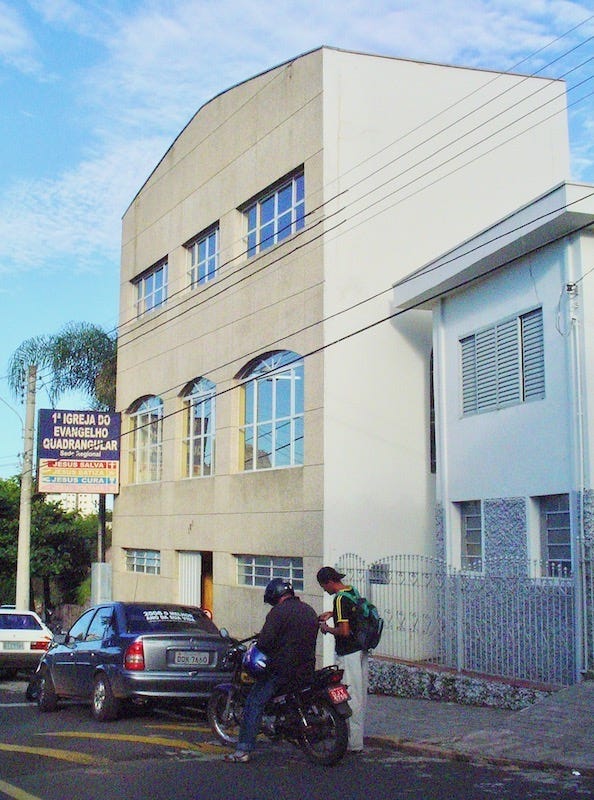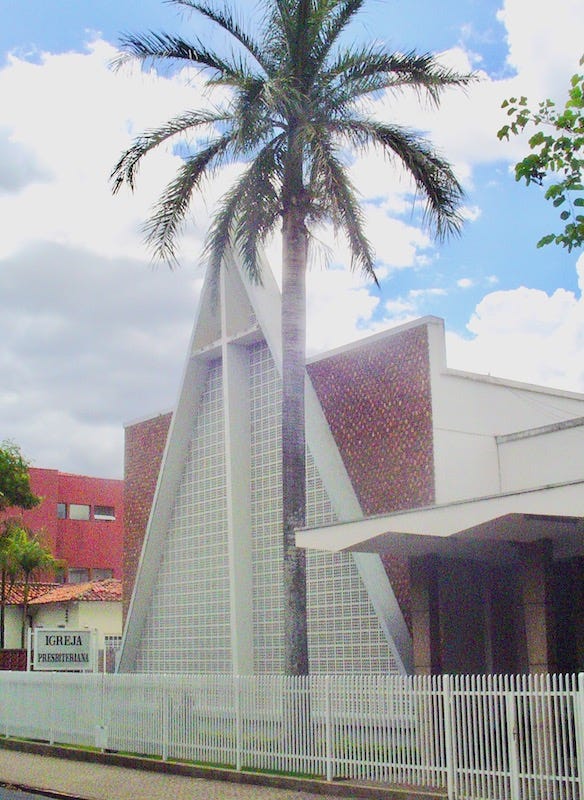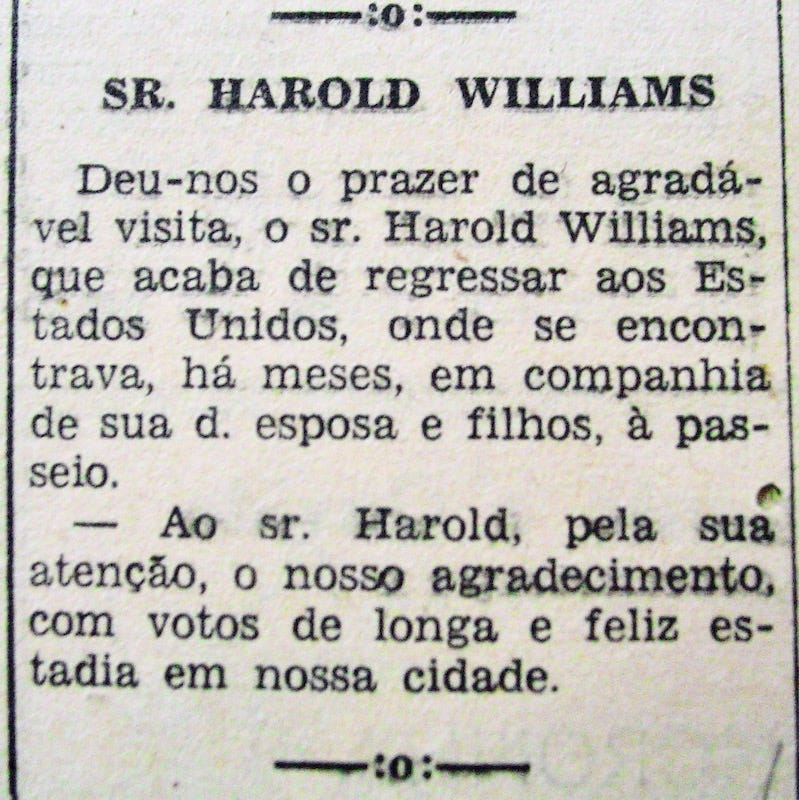Tracing a Key Moment in Global Pentecostalism
The spark that ignited the Brazilian “Second Wave”
This post clears up a minor mystery about the origins of an important movement in global Pentecostal expansion: the “Second Wave” of Brazilian Pentecostalism in the 1950s. Available sources are unclear about many details, and none has pinpointed the spark that lit that fire. I spent a day in the archives of a local newspaper, in the city where it all began.

By coincidence, the inspiration for the Second Wave took place in São João da Boa Vista, a city of about 100 000 people in the state of São Paulo. It is where I spent a year as a teenage exchange student, where my wife is from, where I do a lot of my fieldwork, and where I sit writing this post, while on sabbatical. From the balcony of our sixth-floor rented apartment, I can see Brazil’s first Igreja do Evangelho Quadrangular (Foursquare Gospel Church), less than a kilometre away, across the low valley of the córrego (creek) that wanders through the city.
What is Pentecostalism?
Pentecostalism is a type of Bible-centred Protestant Christianity that emphasizes signs and gifts of the Holy Spirit. Certain powers – especially healing and speaking in tongues – are gifts because they come from God, not from our own abilities. They are signs, because God only gives these gifts to worthy Christians.
Speaking in tongues is the one that most people know about. According to believers, God gives the ability to speak the language of angels – or at least in nonsense syllables that can be interpreted prophetically. The New Testament talks a lot about speaking in tongues: “These signs will accompany those who believe: by using my name they will cast out demons; they will speak in new tongues” (Mark 16:17). It was part of worship in the early churches (Acts 2:2–4, 10:46, 19:6; 1 Corinthians 12, 13, 14). But there is no reliable historical evidence that Christians continued to speak in tongues, until the practice began to pop up here and there in the late 1800s (in Wales, the USA, Argentina). In 1906, the Holy Spirit descended on a small church on Azuza Street in Los Angeles. Thousands of people began speaking tongues. And Pentecostalism took off like a rocket, quickly spreading to countries around the world. Over a hundred years after it began, it is still one of the fastest growing currents of global Christianity.
Healing is what really attracts people to Pentecostalism. For believers, God can cure all ailments – even raising people from the dead. One of the most dramatic moments in Pentecostalism’s global growth was the Cura Divina (divine healing) movement that swept Brazil in the 1950s. This grounded the Second Wave, an explosion of Brazilian-rooted churches that focused on sharing God’s healing power in everyday lives. The first wave of Brazilian Pentecostalism was the early twentieth-century growth of missionary churches, and the third was the rise of Neo-Pentecostalism starting in the late 1960s.
Foursquare Gospel in Brazil

The key figure in the origins of Brazil’s Cura Divina movement was Harold Williams, a former Hollywood actor who played some roles in early westerns. Williams was converted in the Foursquare Gospel Church in Los Angeles, which was founded by Canada’s most famous Christian export, Ontario-born Aimee Semple McPherson. He, his wife Mary and their children spent either one or four years as missionaries for the Foursquare Church in Bolivia (church sources disagree). With Williams’ assistant, Peruvian Pastor Jesus Hermírio Vasquez Ramos, they then became the church’s first missionaries to Brazil. After moving down the coast and looking for missionary opportunities in the big cities of Rio de Janeiro and São Paulo, Williams built and ran a small church in the small city of São João da Boa Vista, in the interior of the state of São Paulo. His church was founded in November, 1951. That first building was later replaced, on the same site, by the current one.
Along with another missionary, Raymond Boatright, Williams was invited in 1952 to speak at revival meetings in São Paulo. Their success led Williams and Boatright to spend much of 1953 and 1954 on the road, preaching to packed revival meetings held in large tents. This set off the explosion of healing Pentecostalism in Brazil: the Second Wave. Williams’ own movement, and his church in São João da Boa Vista, officially took the name of the Igreja do Evangelho Quadrangular (Church of the Foursquare Gospel) in 1954 – or, another source tells us, 1955.

Most accounts focus on Williams and Boatright’s tent revivals of 1953–54 as the beginning of the Second Wave. That makes sense in terms of broad public impact. But perhaps they are missing something. After all, they cannot even agree on the details. Williams and Boatright started using tents because the church building they were using in São Paulo got too crowded. Or the idea came to Williams in São João da Boa Vista, after he spent 30 days praying for guidance. Or the idea of using tents came during a furlough back in the USA, when Williams was inspired by the thought, “Brazilians love circuses. I think they would be drawn to a circus tent for a revival.”
This last source also tells us that, after a 14-day stretch of fasting and prayer, Williams “was surprised by a God-given comprehension of the Brazilian culture.” Must be nice… Antônio Carlos (Tom) Jobim – composer of “The Girl from Ipanema” – famously said, “Brazil is not for beginners.” Over the past four decades – over many visits, lasting from weeks to years – I have spent more time than Williams did in this city where he made his temporary home. I research and write professionally about Brazilian religion and culture. But comprehension remains a long way off. One thing I have learned is that, in Brazil, it makes sense to start by talking to people, not just reading published sources. At least, it puts things in context.
The house with no walls

Here in São João, Williams was known more for his unusual house than for his religious activities. Built right beside his church, it was the only house in the city with no high wall around the property. North-American style. The deep front yard was visible from the street – green with grass and shaded by a large flamboyant tree.
My mother-in-law remembers “Mr. Williams” well. Her father was a friend of his. He modelled his own house on Williams’, with an open yard and no surrounding walls. They met when Williams meshed with a social network of Lebanese immigrants (originally Maronite Christian, but Catholic since their families came to Brazil). Williams first became friends with two rich brothers who spoke fluent English because they spent so much time in Europe. This led to other friendships.

The night it all began
The spark that set off the Second Wave came well before the tent meetings in São Paulo. The only mention I find of this is in William R. Read’s 1967 book, New Patterns of Church Growth in Brazil. He notes correctly that Williams was first welcomed by the city’s Presbyterian church. (My wife, nominally Catholic, grew up attending that church, with her Presbyterian grandmother, now 105 years old. William’s participation is still remembered.) For Read, the moment that sparked the Second Wave came after the Presbyterian pastor, Osmar Serra, invited Williams to speak at a revival session. This was shortly after his return from his furlough back home. Williams prepared by three days of praying and fasting. It was this church meeting that inspired his revivalist project and led directly to his building what became the first Foursquare Gospel church in Brazil. But when was this exactly?

The archives of the oldest local newspaper, O Município, fill out the story of William’s inspiration.
In May, 1951, the Presbyterian church publicly welcomed Williams home after his furlough in the USA.

On Sunday, August 5, the following notice announced that Williams would be giving a “conference” (lecture, sermon) on the topic of “Great Spiritual Awakening in the United States.” This is the event that Read noted in his book, the moment that inspired Williams to start his own revivalist project. Just over a month later, he founded his church.

It was interesting to pinpoint in time the seed of a major religious movement. More interesting is how the life of one person – supported by family and inspired by the faith they shared – had smaller-scale, more local effects. Mr. Williams made ripples that are still visible here over 70 years later – in the archives of the city, in the stories of families that knew him, and in continued conversations about yards and walls.


